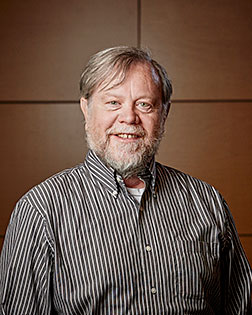- Number 440 |
- June 1, 2015
Ecologist Rich Norby works to integrate experiments, models

Rich Norby.
Rich Norby, an ecologist at DOE's Oak Ridge National Laboratory, has spent his career exploring how ecosystems respond to atmospheric and climate change, including more than a decade studying the effects of elevated carbon dioxide in a Tennessee sweetgum forest as part of the Free-Air CO2 Enrichment (FACE) project at ORNL.
“When you work with forests, the questions are many decades long,” Norby said.
After the ORNL FACE experiment measurements were completed in 2009, Norby and colleagues integrated the mounds of observational data into computer models.
“We can’t do experiments directly to address all the questions related to global forest response over many decades,” he said. “So we have to make use of models to get at these questions. An important reason for intensive experiments is to inform and improve our models.”
Recently, Norby and an international team of researchers from Macquarie University, the University of Western Sydney and the Max Planck Institute for Biogeochemistry set out to assess how the ORNL FACE experiment and a second similar long-term FACE experiment at Duke University compared to eleven vegetation models that simulate various ecological processes. The team summarized its work in a recent study published in Nature Climate Change.
Instead of only benchmarking whether or not an individual model matched the experimental data, the researchers developed an “assumption-centered” approach to evaluate why certain models performed better than others.
Comparing the models to the FACE data sets allowed the team to identify missing or wrong assumptions in the models and pinpoint processes where additional data are needed. The team’s study is helping to guide new FACE experiments that are underway or planned in different biomes and climates, such as the Amazon, Australia, England and Sweden.
“There’s many new questions and value in comparing responses across these different experiments,” Norby said. “We’re setting up a model framework to do that, where all participants are importing data in common format and making sure we measure things in the same way.”
Norby adds that this type of collaborative approach is increasingly important in climate change science, where field researchers and modeling experts are working together more closely than ever before.
“It is a whole philosophy – tightly integrating experiments and modeling,” Norby said. “The entire science community is getting together to do this, which is exciting.” – Morgan McCorkleSubmitted by DOE's Oak Ridge National Laboratory
